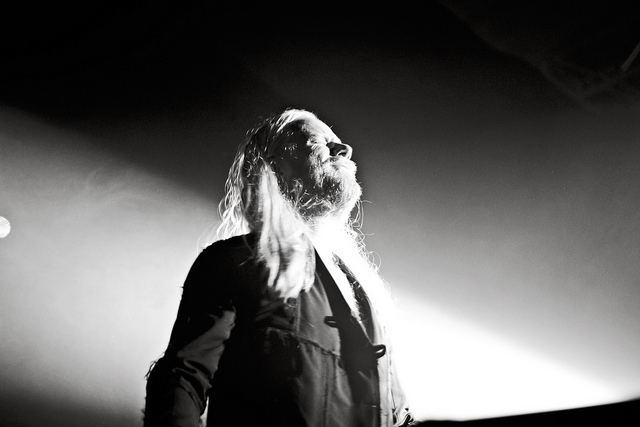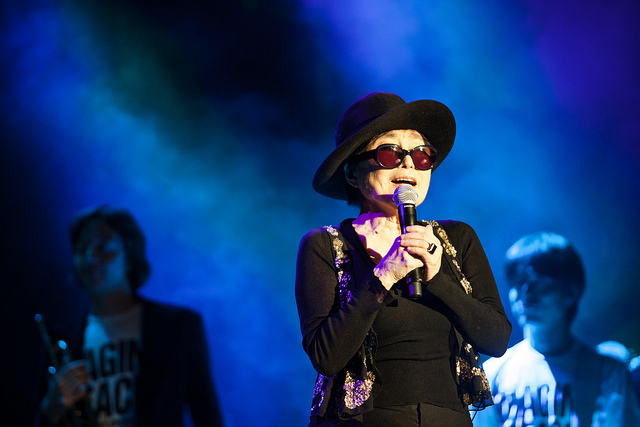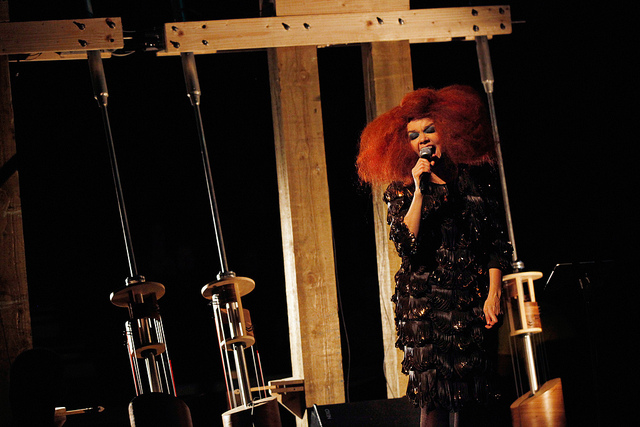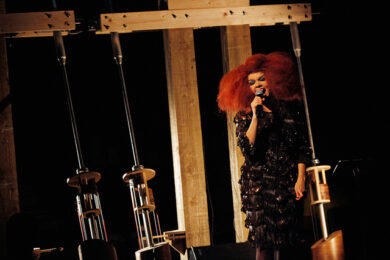Iceland in October, and the weather is as remorselessly harsh as the local sense of humour. Mother Nature hammers the streets of Reykjavik with freezing sheets of Atlantic rain and howling Arctic wind, but such extremes are business as usual in a city where supermarkets sell jars of ash from last year’s Eyjafjallajökull eruption, and puffin-chewing ten-year-olds proudly sport volcano T-shirts adorned with a stark warning: “Don’t Fuck With Iceland”. This is hardcore.
In the decade since I last visited, Iceland has evolved from Damon Albarn-endorsed jet-set hangout for London-jaded hipsters to international pariah/punchline following its catastrophic financial crash and last year’s ash cloud explosion. Personal debt here is now nightmarishly deep. Many Icelanders, including musicians, work two or three jobs just to keep afloat. “Everyone here is screwed,” one young woman tugging on a cigarette in a sub-zero gale cheerfully tells me, “and nobody will ever be able to pay off their debts."
Bleak words. And yet the Reykjavik I rediscover at the 13th annual Iceland Airwaves festival feels like a throbbing hothouse of eclectic sounds and globe-hopping cultural tourists, from a 60-year-old Chicago couple who make the trip every year to beardy boho twentysomethings fresh off the plane from Toyko, Berlin and London. Judging by the crowds spilling from the colourfully painted theatres, lounge bars and wooden churches that serve as festival venues, Iceland’s fertile and incestuous music scene appears to be in remarkably rude health.
With sell-out shows by Björk, Sinéad O’Connor and Yoko Ono, this year’s Airwaves is also the first music festival I have ever attended where the star attractions are all female, each a spiky and self-created original, and each from outside the male-dominated Anglo-American rock tradition. It is tempting to suggest this girl-power bias reflects the traditionally matriarchal and egalitarian values of a Nordic nation recently dubbed by The Guardian as “the world’s most feminist country”, with its openly lesbian Prime Minister Jóhanna Sigurðardóttir and its groundbreaking ban on strip clubs.
Fanciful? Perhaps, but Icelandic pop certainly seems to operate a more gender-equal playing field than most music capitals. Even behind the scenes, this five day festival appears to be run entirely by women with names like Osk, Snork and Moomintrollsdottir. A random pinball through Reykjavik during Airwaves paints a utopian picture of a heavily female-driven scene, from Sóley’s delicate folk-pop balladry to Vicky’s clattery post-grunge racket, Mammut’s art school indie rock and the fearsome Wagnerian doom metal maidens of Angist.
Homegrown electronica also abounds at Airwaves, again with a healthy boy/girl mix. This broad church includes experimental laptop-acoustic fusionists like Kira Kira and Kippi Kaninus, Apparat Organ Quartet’s chilly Kraftwerkian futurism and the propulsive disco throb of GusGus, local legends who recently streamlined themselves from a ramshackle arty-party collective to a sleek techno trance machine. But the oddest electro show I catch is by Bix, who spice up their bass-shuddering EBM gothcore beats with a magician/hypnotist and dancers in scary animal masks. But is the world ready for a Belgian New Beat remix of Donnie Darko?

A bold new addition to the clutch of Airwaves venues scattered across downtown Reykjavik is the fabulous new concert hall Harpa, a disco-pimp Death Star of stained glass and crazy-paving mirrors built on a monumental Bond-villain scale. A controversial project salvaged from a planned harbourside financial centre that sank with Iceland’s economic implosion three years ago, Harpa is an impressively defiant symbol of self-confidence from a nation that remains culturally rich despite being literally bankrupt.
Harpa is the site chosen by Björk to bookend Airwaves with two sold-out hometown shows to launch her Biophilia album. The queen of high art avant-pop repeats her Manchester International Festival run in style and format, performing in the round with a 24-strong all-female choir and a dazzling arsenal of purpose-built electro-mechanical weaponry. But that crackling, guttural, elemental voice is still the most remarkable instrument on display. A techno-pagan blast of fire and ice, ancient and futuristic, geothermal blast and seismic crackle, Björk is tourist-cliché Icelandic to her molten core. A real diamond geyser.
Contemporary classical composers also figure highly on the Airwaves agenda this year. A master of mournful melodic motifs that accumulate emotional weight through stately repetition, Johan Johansson’s show at the Fríkirkjan church is a suitably hushed and devotional affair, fusing polished glitch-tronica with a string quartet and brass band. On the same night, Valgeir Sigurðsson and Daniel Bjarnason of the highly regarded Anglo-Icelandic folk-pop collective Bedroom Community pull off something similar on a grander scale in a specially commissioned collaboration with the Iceland Symphony Orchestra in Harpa, the duo’s excursions into Arvo Pärt-style minimalism sounding lyrical yet unapologetically discordant at times.
The international bill at Airwaves throws up some lovely lo-fi moments too. Like Rainbow Chan, a one woman band from Sydney who won a radio station competition to fly out to Reykjavik to showcase her hand-knitted junk-shop tweetronica. Multicultural Britain also plays a strong hand with the post-dubstep London trio Nedry and the angular quirk-funk of Bristol’s newest young art-rock hopefuls Zun Zun Egui.
Arguably the most warmly received foreign performer is US soft rock revivalist John Grant, seducing the local crowd with his Icelandic phrasebook and his lush but deceptively barbed ballads. The singer’s late night show peaks with a majestically bitter ‘Where Dreams Go to Die’ and new composition ‘Vietnam’, which likens an ex-lover to the notorious military defoliant Agent Orange. An iron fist in a velvet glove, Grant is turning into Rufus Wainwright’s even more acerbic cousin, or maybe a Satanic Harry Nilsson. Classy stuff.
Another hot ticket at Airwaves, Sinéad O’Connor has recently attracted snide media comment for committing the appalling female sins of gaining weight and advertising for a boyfriend in an Irish newspaper. Playing a stripped down semi-acoustic set at Fríkirkjan, the 44-year-old singer mocks her mockers by appearing confident and funny, wearing a corset and tight T-shirt. Mixing old favourites with a smattering of tracks from her forthcoming album Home, O’Connor can sometimes still come across like a bleeding wound of vulnerability and rage. But mostly she is winningly warm and irreverent, hushing the crowd into pin-drop silence before inserting silly rhymes about bananas into ‘Nothing Compares 2 U’. Pure charisma.
On the far northern edge of Reykjavik, the Imagine Peace Tower blasts a skyscraper of light high into the night sky, a monument to John Lennon christened by Yoko Ono in 2007. This year the 78-year-old Ono also plays Airwaves with a reactivated Plastic Ono Band, now a pan-generational two drummer, three guitar collective featuring her son Sean Lennon. In top hat and ragged beard, Lennon looks alarmingly like Jarvis Cocker after a week-long absinthe binge in a vintage clothing store.

Ono’s sprawling late night set and cat-torturing howls eventually drive away all but a rump of brave stragglers, including your humble Quietus reviewer. But along the way she delivers some impressively gnarly free jazz noise rock, duets with the typographically challenged tUnE-yArDs, and rocks the New Wave party classic ‘Walking on Thin Ice’. Even with her 80th birthday looming, Ono still has the power to fill a grand hall, then empty it. Love her or loathe her, that is pretty fucking punk rock. Besides, how many more chances will we get to have a living legend of the 1960s avant-garde shred our senses like this?
Outside Harpa, after the Yoko show, icy rain and wind whip the witch-black Atlantic into a pagan frenzy. Just another gentle reminder from Mother Nature that this is Reykjavik, this is Airwaves, and this is hardcore. Don’t fuck with the goddess Iceland. Because she will smash your puny body to pieces and grind you into volcanic ash.



